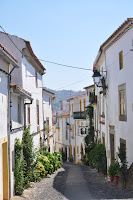I have always been fascinated by traditional costumes and those who know me have already seen me in various outfits from either my own country or foreign countries I have visited, some of which I easily "incorporate" in my daily working routine.
In my recent trip to Castelo de Vide I managed to buy some cards which do show some of these, which I have been told are still worn throughout the Easter festivities of the town.
Embroidered "Rainha" costume - 17th and 18th centuries.
Ruched silk blouse, bolero and skirt in baize embroidered with braid and ribbons to imitate the golden embroidery of Queen Isabel's dress.
Farmworkers - 19th century.
Woman - Neckerchief, satin blouse with front, felt skirt with bars of velvet, hand-embroidered apron, lace stockings and calfskin shoes.
Girl - Full-collared blouse, felt skirt embroidered with braid, hand-embroidered merino apron.
Man - Felt hat, shirt with shirt-front, calfskin boots and woollen cloth jacket.
Olive pickers - 19th and early 20th centuries.
Cotton kerchief, calico blouse, cloth skirt (transformed into breeches), calico apron caught up, hand woven cotton stockings, heavy leather shoes.
(Used during the olive harvest, one of the most important activities in the region).
Vine Leaf skirt - 19th century.
Skirt made of wollen cloth embroidered with braid and ribbon.
(Used by unmarried girls over Carnival).
Festive costume - Farm land owners - 19th century.
Woman - Silk blouse with lace, skirt with strip hand embroidered with chain stitch, calfskin shoes.
Man - Shirt with shirt front, broadcloth trousers, waistcoat and jacket.
(Used on Sunday "to visit God", which is the common local way to say to go to church).
Hay collector - 19th and 20th centuries.
Straw hat, cotton kerchief covering most of the face, knee-length skirt (transformed into breeches) and caught up apron.
"Côca" - 18th and 19th centuries.
Mantilla of silk cloth with veil, silk blouse, skirt, stockings and shoes.
(This was essentially a wedding dress, but was also used to pay visits of condolence to families in mourning and/or to go the cemetery on all Saints' Day.













































































